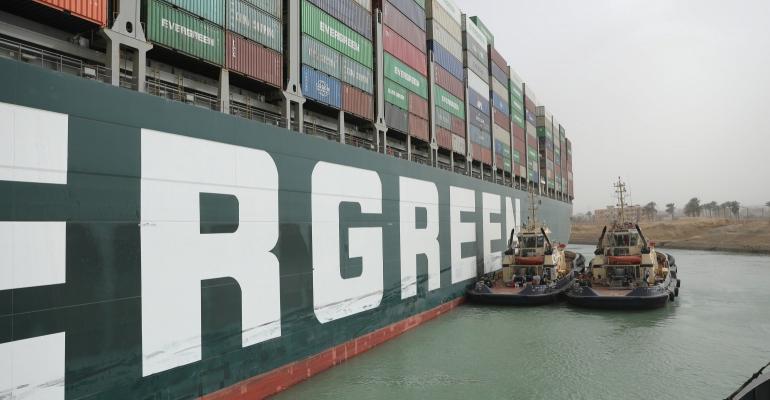Our oceans have been in crisis for decades, but only recently was an ‘ocean emergency’ declared !
Leakage of methane and hydrogen and the release of black carbon to name a few are very serious climate forces.
We would also love to see a ‘wind propulsion incentive’ during the transit of the Suez Canal, as that would send a significant message to the industry
By the end of this year, we will have 25 demonstrator vessels sailing in the world fleet.
By : Magdy Sadek ( Saudi Magazine LEADERS MENA )
GAVIN ALLWRIGHT has been Secretary General of the International Windship Association (IWSA) since it was established in 2014. This not-for-profit grouping of maritime wind propulsion companies and projects supported by academia & NGOs is working to promote and facilitate the uptake of wind propulsion solutions in commercial shipping. He sits on the International Maritime Organisation (IMO) Maritime Technology Cooperation Centres (MTCC) stakeholder’s advisory committee and is a non-executive board member of the World Wind Energy Association (WWEA).
Gavin has presented and chaired numerous international fora including the Royal Institute of Naval Architects (RINA) Shipping Efficiency & Wind Propulsion conferences and led the team that organized the ground-breaking Ambition 1.5C: Global Shipping’s Action Plan summit at COP23 in Bonn, Germany
He is an advisor on several EU and international research projects, including WASP, WiSP, VTAS, and Decarbonising UK Freight. Gavin holds a Masters’s degree in Sustainable Development, specializing in small-scale sustainable shipping and logistics in developing countries. He has contributed to numerous studies on alternative propulsion solutions and most recently contributed as an expert reviewer to the IPCC Special Report on 1.5C Global Warming.
Do you have any ideas or research papers to contribute to this Cop27?
Through our efforts at IMO and our continued engagement in the industry, the NGO community, and with policymakers worldwide the message we will send to the summit is that shipping, which makes up around 3% of human greenhouse gas emissions, has a toolbox of solutions that can decarbonize this nominally labeled hard-to-abate sector, quickly, deeply and effectively free of charge.
“How can that possibly be true?
Will be the cry from policymakers, “this sounds too easy to be true”, and usually that means it is, however shipping has unique access to an inexhaustible, abundant, globally available, and free energy source that doesn’t require additional infrastructure and can be rolled out extensively through the fleet today. Can we power the modern fleet? Ought to be possible though with a combination of retrofits and increasing numbers of optimized newbuilds the ability to cover 20% of the fleet’s energy needs is feasible. This capability could, with a systematic rollout, deliver that within this decade.
What that then means, is wind alone at this level would save enough on fuel costs to pay for itself within a few years at today’s prices, but more importantly effectively cover the entire $1.4-$1.9 trillion required to fully decarbonize the global fleet by 2050. Moreover, if you link this with operational changes such as reductions in speed, weather routing for wind, etc. And energy efficiency measures, you could be looking to reduce the energy required by the fleet by an additional 40%+. This is all using readily available practices and technologies – thus unlocking the decarbonization puzzle today.

What do you think about cooperating with the Maritime Transport Authority?!
We always cooperate with policymakers and those in charge of steering the maritime transport decarbonization pathway, at either regional or international levels.
By the end of this year, we will have 25 demonstrator vessels sailing in the world fleet. While this is still a small number, it has effectively provided three or more points of reference to the industry on a technology basis and increasingly on a ship segment basis.
Thus, the MPA and other actors have an increasing number of examples of vessel operation. In addition, they also have a better understanding of how and where these can be used.
This virtuous circle will be further boosted by the surge in additional vessels slated for 2023, with anything from 20-25 additional vessels and installations on the books. We would also love to see a ‘wind propulsion incentive’ during the transit of the Suez Canal, as that would send a significant message to the industry and the world that this is a key and zero-emissions option that should be supported.
What do you expect from the results or recommendations of this summit?!
This is a difficult question to answer. I would like to see a renewed commitment to all of the pledges made in shipping and energy at COP26, but the critical thing is action not more words.
Developed countries have an extremely terrible record of not living up to their climate commitments as they pertain to funding the climate fund (which is frankly a drop in the ocean despite its size), but also by lowering the bar to accessing funds, technologies, and expertise. Unfortunately, I don’t expect much movement there, just words, however with Egypt’s strong leadership, that could change.
One thing that I do expect is that the impasse in the agreement for protecting our oceans will be moved and that is paramount.

Our oceans have been in crisis for decades, but only recently was an ‘ocean emergency’ declared, which is difficult to understand. Our impacts and actions in the marine environment will be by far the deciding factor on climate change.
This is due to ocean acidification, blue carbon sequestration, underwater noise, pollution, biodiversity, and so on. This all may be out of sight to many policymakers and people, but in shipping as in fisheries, we know this instinctively.
Shipping has the opportunity to step forward as a pioneer in this field through the many actions it is already taking, but we have to be realistic, our scorecard is not stellar – emissions from shipping continue to rise and many unsustainable practices continue but as I said before we have the tools to get the job done, and as I have already stated, I and our association members believe that we are developing the critical key to unlocking that potential.
life cycle of fuels

We will also likely see further movement on the life cycle of fuels and alternative energy sources. We should fully embrace what we call a Well-to-Wake appraisal of fuels in the shipping world, including materials circularity, embedded energy, and externalities as part of our assessment of fossil fuel (and alternative energy) sources.
We are facing serious climatic jeopardy, and a business-as-usual approach simply won’t cut it and I think policymakers are increasingly aware of that. I expect further pressure to adopt a 20-year Global Warming Potential (GWP) in all fuel and energy source assessments will be seen.
This means that the leakage of methane and hydrogen and the release of black carbon to name a few are very serious climate forces. That message seems to be resonating. If we face potential environmental tipping points, which could signal uncontrollable climate feedback in the next 20 years as most scientists agree we are, then holding to a 100-year GWP makes no sense whatsoever.

What issues need to be addressed in the current and future stages?
I have touched on some of the macro issues above, and I expect there to be some progress made. However, should the industry leave it to policymakers, politicians, and regulators to decide on a course of conduct? The answer is no, however, the reality is that just as with every other industry we have first movers, early adopters, and then a fairly large segment of late adopters that are subsequently moved by regulation only.
In a perfect world, the removal of all direct and indirect subsidies from our current energy markets would be ideal. Hand-in-hand with this would be the internalization of all externalized costs such as health impacts, climate, waste disposal, air pollution, security costs, liability costs, and so on.
This would reveal the true cost of all energy sources and enable us to fully understand the ‘real’ costs of the energy we utilize.
We don’t live in that idyllic world. Because of this, my priorities should be that we develop carbon and other externality taxes/levies that are then returned to the industry. This will support the uptake of the latest technologies and fuels but are also there to help smooth the transition for SIDS, LDCs, and small industry players. This is indeed being called for by a significant part of the industry, which is a historic departure from business-as-usual in shipping.
Move very quickly
Likewise, we need to move very quickly, so that we can focus on the 60% change and more that can be achieved. At the same time, we should begin to make the investments required for the more expensive and cumbersome alternative, low-carbon fuels of the future. They will take decades to scale to a really meaningful level of supply and manageable cost.
Protect and support first movers, lower the bar on finance and remove compliance costs from technology SMEs in the industry. Innovativeness, speed of movement, and flexibility in application are also significant characteristics of these companies.
Finally, I would like to conclude with probably the most significant points. That is all of this transition needs to follow three key criteria as we have no more time to sail into any more dead ends:
(i) Safe & Transparent Transition – we pride ourselves on Safety first traditions that have served shipping and the maritime community well. The fuels and technologies that work on land may not necessarily work in the marine environment, which is characterized by corrosion, harsh conditions, and drudgery. We must ensure all pathways are rigorously assessed and that what may be a brand-new hotel in one of the most developed regions of the world, may not translate to a small 30-year-old bulker, chartered out and operating in tropical waters. We also must ensure that the life cycle of all of the technologies and fuels we are developing can withstand this environment for 20-30 years safely. All of this needs to be done in a transparent and open
(ii) Robust & Viable Transition – economic, socially acceptable, non-polluting throughout. The solutions we adopt have to make sense from the perspective of the triple bottom line. They need to be robust from the onset. The financial world must change its mindset from ‘green’ investment criteria to all investment is green, unless it is not. Identify those investments that are damaging and unsustainable, and let the market and consumers decide which ones they prefer. We must focus on technologies and solutions that can be rolled out today. It is a ‘NOW’ problem that needs ‘NOW’ solutions.
(iii) Equitable & Just Transition – this is fundamental. If this transition is to work, then the poorest, marginalized, excluded and opportunity-deprived segments of the world and the economy must be brought along. If a carbon tax is paid by a developing country, then those proceeds should go straight back to that country for the development of alternatives that are designed, tested, and manufactured in those countries rather than being extracted to the developed world, and then those fuels and technologies are sold back to them. Seafarers need to be treated as vital workers they are and communities dependent on shipping, ports, trade, fisheries, etc. ARRANGED AS EQUAL AND VALUED Stakeholders IN THE TRANSITION, NOT AS AFTERTHOUGHTS.
If we can follow these criteria, then shipping has the opportunity to lead the energy transition, decarbonization, and sustainability charge. A lack of bold intentions and the right toolbox is not the problem. It is sustained action across the board with all stakeholders engaged that matters, and we are not alone in that. As Einstein said: “Insanity is doing the same thing over and over and expecting different results.”We still have the opportunity to break that cycle.
Leaders MENA Magazine meets IWSA Secretary general to speak about Cop 27
















